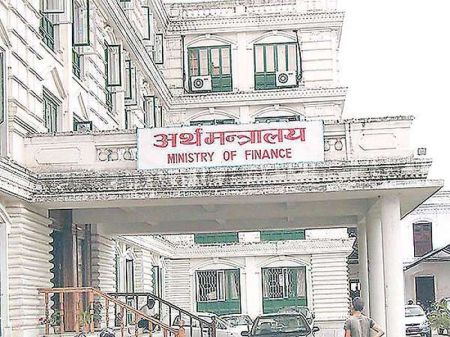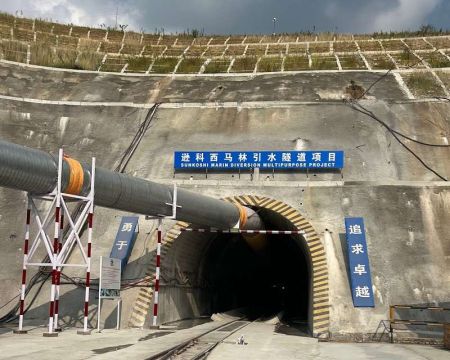
Income received as the Nepali workers’ remittances working abroad has become an automatic instrument for poverty reduction in Nepal. Remittance has been recognised as a key to solve various economic ills afflicting the country. Moreover, it has raised some obvious questions. For instance, long the national economy can solely depend on the source of remittance to sustain itself? Is it possible to use the remitted money to improve social livelihood of the Nepali people or, can it be used in more productive sector? Can our policymakers think beyond the box of remittance economy?
55 New Business Age | September 2012

COVER STORY
The total households receiving remittances in Nepal stood at 55.8 per cent in the year 2010-11 as revealed by the findings of Nepal Living Standards Survey (NLSS)- III released by the Central Bureau of Statistics (CBS). This is a sharp rise from the year 2003-04 when only 31.9 per cent households in Nepal received remittances. Another remarkable statistic in the report was the 18 per cent decline in absolute poverty in the six years between 2003-04 and 2009- 10. According to the report, only 13 per cent Nepalis now remain below the absolute poverty line (the benchmark being 2,200-calorie intake per day per person). Nepal ranks sixth among the countries in terms of Remittances-to- GDP ratio as stated in the World Bank Report-2011. It rose from Rs 47.5 billion in 2001-02 to Rs 231.73 billion in 2009- 10. Remittances-to-GDP ratio almost doubled from 10.3 per cent in 2001-02 to 19.6 per cent in 2009-10. Economists estimate that this figure will rise to 20 per cent in 2012-2014.
It is estimated that approximately 2.2 million Nepalis are working as migrant workers in various countries. Nearly 90 per cent of migrant workers have found employment in Qatar, Malaysia, Saudi Arabia, the UAE, and Kuwait. Among them, 10 per cent of migrant labors are female. According to Bal Bahadur Tamang, the President of Foreign Employment Association of Nepal, the growing construction business in the Gulf countries has created a demand for large number of Nepali workers. “Qatar is hosting a showpiece World Cup Football tournament in 2022 and therefore, the amount of construction work happening there has increased the demand of Nepali workers substantially,” informed Tamang.
Increasing remittance flow has emerged as a favored poverty alleviation strategy in developing countries, particularly in Nepal. Policymakers believe that the financial contribution from migrant workers has provided impetus to development activities. They also opine that the scope of such revenue should be further enhanced. Nara Bahadur Thapa, Chief Manager of Nepal Rastra Bank at Biratnagar said, “The robust relationship between the growth in remittance and the reduction in poverty has evolved on account of a significant growth in the number of rural poor people seeking jobs in the Gulf countries.”
“Annually, Nepal is receiving Rs 200 billion as remittance,” shared Dr Ganesh Gurung, a Remittance Economist. Based on the data of the Department of Foreign Employment, 1,500 people leave the country for foreign employment every day on an average as of August 2011. Quite naturally, the country has also been receiving proportional amount of remittances from these migrant workers employed abroad. From mid-July to mid-August 2011, the number of Nepalis going abroad for jobs was 45,165. This heavy reliance on foreign employment has shifted the Nepali economy from an agriculture-based economy towards a remittance-based one.
The NLSS, 2010-11 reported that the common Nepalis’ access to basic facilities has improved over the years. Despite political upheavals and unrest, the average household income of Nepalis has increased by more than four-fold to Rs 202,374 over the span of 15 years due to increased receipt of remittances. Thapa shared that the remittance thus received is widely spent on daily consumption, followed by loan repayment and household property instead of capital formation. A Nepal Rastra Bank (NRB) report says that 78.9 per cent of the remittance is used on daily consumption, whereas 7.1 per cent of the remittance is used to repay loans followed by 4.5 per cent on household property, 3.5 per cent on education and only a minimal 2.4 per cent is used for capital formation. According to Dr Gurung, the increased remittance per household has not only increased consumption pattern but changed the social structure too. The nominal per capita consumption expenditure in aggregate increased from Rs 15,848 in 2003-04 to Rs 34,829 in 2010, at an annual average growth rate of 14 per cent. The survey also identified urban hills (9 per cent) and Kathmandu (11 per cent) having the least poor population while the highest population identified as poor live in the mountains (42 per cent) and rural hills in the Mid and Far-West regions (37 per cent).
According to Tamang, a significant chunk of the money received via remittance is being spent on imports and real estate instead of it being invested in productive sectors. The main challenge does not lie in receiving remittance but in channelizing it into productive use. Therefore, remittance should be included in the national development agenda to monitor its use. Though the government has given permission to manpower agencies to open foreign currency account in Nepali commercial banks, the government’s responsibility does not end here. Apart from monitoring and facilitating the use of this income, the government should encourage migrants to hold their income in financial assets within the country rather than abroad.
“Income received from remittance source has become an automatic instrument for poverty reduction in Nepal as both the government and the private sector have failed to create adequate number of jobs,” said Thapa. If we compare the domestic savings-to- GDP ratio, which is currently around 10 per cent, and national savings-to- GDP ratio standing at 36.7 per cent, the difference is largely due to remittance. Against the national savings-to-GDP ratio at 36.7 per cent, the total fixed investment-to-GDP ratio is 19.6 per cent, reflecting the failure of Nepali society to make productive use of remittance driven national savings. As of mid-June 2012, foreign exchange stood at Rs 427 billion, sufficient nough to cover merchandise and services import of around 10 months. This reflects two things. First, remittance is an important source of foreign exchange earnings, underpinning macroeconomic stability of Nepal.
Second, the magnitude of foreign exchange indicates that both the government and the private sector have failed to make productive use of foreign exchange accumulated from remittance. Gurung opines that there is no question of utilising remittance for income generating activities for families living below the poverty line. In their case, remittance will take care of consumption. However, the families managing to save out of remittance can be encouraged to invest in income generating activities that could be an issue of micro management of remittance. Similarly, families engaged in agricultural activities and receiving remittance in excess of their consumption requirements should be encouraged to invest in high yielding crops and animal husbandry. This will help boost the agricultural production and consequently, their incomes.
On the other hand, families residing in urban and semi-urban areas should be encouraged to invest in small services such as tailoring, taxi driving and undertaking petty businesses. For this to happen, the government can help establish multipurpose urban cooperatives. Lila Prasad Sitaula, Executive Director at Foreign Exchange Management Department of Nepal Rastra Bank, said, “The government, together with the NRB has introduced few important policies to utilize remittance productively. One of those is the issuance of remittance bond targeting migrant workers. Along with it, the NRB is formulating a policy to encourage banks and financial institutions for opening up branches in the rural areas, thus, bringing money in the banking system and channelize it in the productive sector. Furthermore, some provisions have been made to allow remittance companies to manage their forex balance in a more profitable manner, added Sitaula.
The government also started issuing foreign employment bond for mobilizing funds and making productive use of remittance since 2009-10 but so far, it has failed to gain popularity among the Nepali migrant workers abroad. According to Chandra Dhakal, Chairman of Nepal Remitters’ Association, remittance is the major factor in improving Nepal’s position in Human Development Index and improving poverty level. Remittance has played a major role in improving livelihood of millions of Nepalis. It has helped people have better access to health, education and sanitation. Dhakal added that the time has come to think about the productive investment of remittance for economic development of the country because capital has been a major constraint.
The Monetary Policy of 2012-13 has encouraged and facilitated those companies wishing to establish remittance business in various regions and countries. “We have realized the need for further expanding money transfer agencies to the countries where the supply of remitting service is few or not in existence,” shared Sitaula. Additionally, necessary bylaws have been introduced governing money transfer business activities. The government should prepare proper plans and policies in order to encourage the migrant workers to use formal channels instead of using illegal channels like ‘hundi’. Besides, the government should support the recruitment agencies in receiving recruitment charges, visa charges etc through proper banking channels which should automatically reduce the use of illegal banking channels.
International Money Express (IME) was the first Nepali financial institution starting its services to control the flow of remittance through banking channel twelve years ago. And since the last few years, commercial banks through their representatives and agents have also been involving in money remitting business. As per a recent report of central bank, the total remittance for the first 11 month of FY 2011-12 stood at Rs 320.38 billion showing a growth of 39.6 per cent compared to a growth of 10.1 per cent during the corresponding period of the previous year. Dhakal said, “Though we don’t have any data related to remittance coming through remittance companies, we can estimate that more than 70 per cent of it is channeled through remittance companies.” According to him, remittance companies are doing their best in increasing their network and enhancing their service to bring more remittances through formal channels. The central bank and the government should cooperate and facilitate remittance companies in this noble endeavor, he said.
“Commercial banks are coming into this business and making it more competitive, however, there is a huge misunderstanding in the scope of work for remittance companies and commercial,” said Dhakal. The present policies have been formulated on the assumption that remittance companies will bring the foreign currency and sell it to commercial banks so that both will be benefited. It is an irony that remittance companies are compelled to sell foreign currency to commercial banks, with whom they are competing at source. Since there is huge disparity in facilities available to remittance companies and commercial banks in terms of foreign currency, the central bank needs to review its policy to ensure sustainability of remittance companies, which are playing an instrumental role in Nepal’s inward remittance. On the other hand, the comfortable reserve position in the country leads to sufficient liquidity in the banking system that is being channelized into productive sectors. Moreover, the increase of foreign exchange reserves allows moving towards gradual liberalization of foreign exchange market.
“Preserving the value of foreign exchange is the main concern of the NRB,” said Sitaula. According to him, the central bank has been managing its foreign currency assets keeping it in major international currencies and different asset portfolios in accordance with the principle of portfolio diversification and minimizing currency risk. “A chunk of reserves is invested in highly liquid securities especially sovereign bonds and rest is placed with foreign central banks, BIS and different highly rated foreign commercial banks based on the ratings of international rating agencies such as Standard & Poor’s and Moody’s,” shared Sitaula. While safety and liquidity constitute the main objectives of reserve management in Nepal, return optimization becomes an embedded strategy within this framework, he added.
Remittance increases foreign currency availability in the domestic market and raises national savings. Availability of foreign currency, in turn, facilitates financing of essential import and can avert possible balance of payments (BoP) crisis. Despite the rising trade deficit, Nepal witnessed a record current account as well as BoP surplus in the last year because of substantial flow of remittances. Had remittance flows stagnated last year, Nepal would have witnessed deficit in the current account and lesser BoP surplus, said Sitaula. Remittances alone can finance about 90 percent of merchandise trade deficit of the country.
These facts reveal a crucial role remittances play in attaining macroeconomic stability in the country. Though increasing remittance has its own advantages, it is also true that over dependency on it in the end will eventually lead to economic failure if the flow of remittance is disrupted. “Of course, nothing would be better than bringing development projects with sufficient funding to utilize the labor force in Nepal itself. For this, the long-term focus ought to be the development of entrepreneurial capabilities of the Nepalis so that remittances could be turned into productive investment that brings higher growth and employment generation,” said Gurung.
However, having said that, remittance has been the only hope in recent times to rescue the faltering economy from the low-level equilibrium trap when the implementation of capital expenditure programme is likely to go on a wild goose chase. Remittance has been imperative for survival, poverty reduction, and eliminating impoverished condition of life in the country. At the same time, the government has to resolve these problems, as remittance is one of the growing and most crucial sectors of the economy.
COVER STORY
‘Remittances can have Long-term Impact if Channeled into Productive Investment’

DR GANESH GURUNG
Remittance Economist
How do you view the contribution of remittance to the reduction of poverty in Nepal?
This, in fact, is an interesting aspect. The post conflict political situation has not witnessed major economic growth and hence unemployment and underemployment is an ever growing phenomenon. The political unrest decelerated the pace of industrial expansion and halted plenty of small and medium enterprises all over the country creating unemployment throughout the country. In that situation, a huge number of migrant workers amplified the number because of which, foreign employment became an emerging business in Nepal’s context.
In my opinion, remittance has played a vital role in poverty reduction. Various reports and planning documents published in recent times have attributed the dramatic fall in absolute poverty to the inflow of remittances in Nepal. The percentage of all households receiving remittances in Nepal during the year 2010/11 was 55.8 per cent. This is a sharp rise from the year 2003/04 when it stood at 31.9 per cent. There has been an 18 per cent decline in absolute poverty in the six years between 2003/04 and 2009/10. Therefore, according to me, foreign employment is a major economic phenomenon in Nepal and its relation to the economic growth of the country is integral.
What is the trend of use of remittance in Nepal in general households? What is the ratio of its use in productive and unproductive sectors? How do you analyze such trends?
I believe that there are also some long-term opportunities brought about by foreign employment. Children of the foreign employment workers are getting quality education paid for by the remittances from their parents. The nation can benefit in the long term out of this trend as skilled and educated manpower is produced for the economy.
The remittance sent by the migrant workers can be used to further generate wealth in the country. Besides spending on consumption, it has to be invested in productive sectors, which would bring about some positive change on the major macroeconomic variables of the country. Remittances can produce long term impact only if it is channeled into productive investment. Going by the current trends of consumption in Nepal, if the remittances are soaked up by consumption only and are not turned into investments, the short term boost provided by it in the economy will not be sustainable. Productivity will decline and the economic choices get tougher if the situation is not addressed in time and is stalled being shortly content with the remittance-based income. More remittance money is spent on consumption than in any other aspects. Only 2.4 per cent of remittance money is spent for capital formation in our country.
Due to increase in revenues from remittances, the currency of a country becomes stronger compared to that of other nations resulting in exports becoming more expensive for other countries to buy. This can make the manufacturing sector less competitive. Thus, with the increase in the purchasing capacity of households receiving remittance, there is high demand of consumption and imported goods. There has been an appreciation of real exchange rate due to rise in the price of non-tradable with respect to tradable. Furthermore, there has been an erosion of manufacturing sector entailing to their reduced competitiveness.
How do you compare the remittance figures between today and five years ago?
Despite the huge contribution of remittance to GDP, Nepal’s economic growth rate has never exceeded 4 per cent except in 2005 although the indication is that remittance will go up in the years to come. A remittance share of 20 per cent of the total GDP should have created enough employment opportunities, but the unemployment rate still stands at 42 per cent. Furthermore, there appears to be an inversely proportional relationship between employment abroad and industrial growth. For instance, industrial production growth rate was only 1.8 per cent in 2011 whereas from 2002 to 2005, the growth rate was 8.7 per cent when remittance inflow was far less. In this ratio, the remittance pattern is in the increasing trend if we compare the figures of 2010/11 and 2004/05. However, the challenge is to channelize the remittance in productive sector.
What is the contribution of remittance in GDP?
It is estimated that the number of Nepali migrant workers is officially 1.4 million and the number of undocumented migrant workers is estimated to be the same. Annually, Nepal is receiving Rs 200 billion as remittance and its contribution to GDP is about 20 per cent. According to World Bank report - 2011, Nepal ranks sixth among countries in whose GDP remittance holds a very high share. It rose from Rs 47.5 billion in 2001/02 to Rs 231.73 billion in 2009/10. Remittance-to-GDP ratio almost doubled from 10.3 per cent in 2001/02 to 19.6 per cent in 2009/10. Therefore, we can say that there has been a positive impact of remittance in GDP.
How successful has the state become to utilize the remittance income in the development activities?
It is rather disappointing that the state has not been able to utilize the remittance to the optimal level. Very less has been done in this aspect. With a huge number of migrant workers working across the globe, remittances are emerging as a new way for alleviating poverty in the developing and least developed countries.
Due to unhealthy investment environment in the home country, remittance money has not been used productively which has made Nepal a consumption oriented economy rather than an investment oriented one. This has slowed the pace of development activities in the country. Presently, 78.9 per cent of remittance money is used for daily consumption while only 2.4 per cent is being used in the productive sector. So, the government should create an investment friendly environment in order to use the remittance money in the productive sector.
In my opinion, the migrant workers should be trained and well informed about what they can do with the money they earn at destination countries. The recruiting agencies should take them in confidence that even after they return to their country, they could have a secure future. Different plans and policies have to be made to create investment friendly environment for these workers. In addition, proper investment environment in the home country acts as a backup in case of emergencies oversees and even during financial crisis. Similarly, the government should introduce measures to encourage savings among migrant workers and their remittance recipient families.
What is your vision to utilize the expertise of the private sector as well as the state to utilize the earning from remittance?
Private sector has a great role to play here. They are the ones who should be making attractive and feasible business ventures that are appropriate for migrants. Migrant workers do not know about the viable projects where their money can be invested. Therefore, in collaboration with these migrant workers, the private sector should establish business ventures that are not only viable but also fulfill the need of the country. Thus, both will have a win-win situation.
People recruited for foreign must be provided several types of training that can enhance their productivity to get better jobs. Proper trainings should be provided to these workers to gain required skills in the destination country. Another major area where private companies are key players is the remittance receiving procedures. There are dozens of private money transfer companies that are providing the service and transferring money through legal and formal channels. The spread of such private services to even the rural areas of the country suggests increasing demand for their services and profitability potential.
What is the situation of Labor Desk and Welfare Fund in the present situation? Is there enough transparency?
The Labor Desk has acted more as an extended bureaucracy on the part of the government. The Welfare Fund has collected Rs one billion as of September 2011. However, no significant work has been accomplished to properly utilize this amount. There is less transparency regarding the fund collected thus far. In my opinion, the fund should be utilized to provide trainings, skill-enhancing workshops, and information required for foreign employment. This way, the migrant workers will be well equipped with required skills and well informed about the destination country. This will automatically minimize the risk of the labors being cheated or discriminated at the host nation.
What is the contribution of remittance in Balance of Payments?
Nepal was compelled to borrow $42.5 million from the International Monetary Fund under its rapid credit facility to address BoP deficit one-and-a-half years ago. However, the acceleration in the growth of remittance along with the improvement in the service account has helped maintain a comfortable balance of payments (BoP) situation. After remaining in deficit for two years, the country’s BoP turned surplus in the second last month of the last fiscal year and has continued to grow since. In the same period last year, the BoP had recorded a deficit of Rs 5.72 billion.
An initiative of the government-foreign employment bond has said to have failed miserably. How can such initiatives be made successful?
In my opinion, it is necessary to create a mechanism that provides incentives to the stakeholders so that they are keen to sell on the one hand and on the other, interest rate and other facilities given are not attractive for the migrant workers. Thus, the government should make the bond an attractive package and provide them some more incentive so that it is comparatively profitable for them to buy.
Foreign employment bond is one of the key instruments that the government has adopted to raise internal loans. However, lack of awareness and complicated procedures are responsible for the low subscription. The first foreign employment bond, issued in fiscal year 2009-10 had seen subscription worth Rs 4.6 million of the total issue of Rs one billion at 9.5 per cent interest. Likewise, last year too, bonds worth only Rs four million of the total issue worth Rs five billion were sold.
The repetitive failure of the bond to attract enough investment from the migrant worker community has been attributed to the absence of proper marketing channels. The failure of the last two batches had got NRB to look into diverse markets allowing even Non Resident Nepalis (NRN) and returnee migrant workers to purchase the bond instead of only focusing on migrant workers in the Gulf countries and Malaysia. The layman is missing out on booking good returns by investing in bonds due to lack of awareness about investing in government securities.
COVER STORY

BAL BAHADUR TAMANG
President
Foreign Employment Association
Which are the countries currently demanding Nepali labors on a big scale? What kind of wages do these migrant workers earn abroad?
Most of the world’s estimated 150 million migrants are people searching for improved economic opportunities abroad. Nepal has not been able to escape this phenomenon either. Economic migration to the Middle East from countries in South Asia and other parts of the world was spurred-on by the oil boom in the early 1970s. The reasons behind the migration to the Gulf countries are almost same in Nepal as other parts of the world. Foreign labor migration has developed in such a way over the decades that it has shifted Nepal’s agricultural-based economy towards a remittance based one.
Nepalis labors are demanded mostly in countries like Malaysia, Dubai, Saudi Arabia and Qatar. Most of the Nepali labors ranging from unskilled, semi-skilled and skilled are equally opting to receive foreign employment to these countries. The minimal wage rate for unskilled labor is 800, semi-skilled is 1,000 and for skilled labor is 1,200 Saudi Riyal. Apart from it, some European countries are also demanding skilled Nepali labors. However, the Middle East nations stand above in this aspect.
Why is it that the Nepali manpower agencies have not been able to send skilled manpower to the developed countries? How can this problem be resolved?
There is a demand of skilled workers in the international labor market. However, there is a vast difference while comparing the educational and technical standards of Nepali labors with those of the other countries. It is believed that Nepali workers are accepted in East and South Asia as well as the Gulf countries only because they come cheap and do whatever job is given to them. They lack required technical skills which makes it difficult for them to get visas for recruitment in the developed nations.
I strongly believe that the government should improve the curriculum in schools so that it can provide more practice-based knowledge. Apart from it, the government should also conduct consultation meetings with the experts, occupational groups, trade unions and foreign employment enterprises to make rules and regulations for the promotion and management of foreign employment occupation.
How do you view the conduct of manpower agencies operating in Nepal? What are the measures that your association is initiating to give this industry more credibility?
The main objective of the association is to monitor the manpower agencies providing foreign employment services, for their efficacy and transparency. We are working to make foreign employment business safe, well managed and decent as well as protect the rights and interests of the foreign bound workers and foreign employment entrepreneurs. There are many incidences of fake employment contracts, visas and forged documents etc. The result is that many Nepalis become stranded in foreign countries or are deported from these destinations where they go for work.
A large number of unlicensed agencies exist in the manpower market in Nepal today. Estimates suggest that more than 200 unlicensed agencies are clandestinely involved in this business and bypass all official channels. For example, there are some manpower agencies charging more than Rs 2-3 lakhs per person for a position of manual labor in the Gulf countries or Malaysia. However, the actual cost should be much less. The association is closely monitoring the manpower agencies to make them follow the code and conduct of FEA.
A high-level advisory committee with the participation of the Ministries of Labor and Finance, the National Planning Commission and foreign employment organizations should jointly work, in order to expand foreign employment opportunities and increment the reliability of agents. The association is preparing a draft of proposal concerning the trainings that is to be provided to the workers seeking foreign employment opportunities in the days ahead.
How can ‘Hundi’ transaction be controlled? Why have manpower agencies not been able to encourage the migrant workers to use formal channels for remittance flow?
Remittance is one of the important sources of income. The contribution of remittance on Gross National Product is 23.6 per cent. In some cases, it seems that the process of remittance is lengthy and costly. The government should prepare proper plans and policies in order to encourage the migrant workers to use formal channels for remittance purpose. It should provide orientation classes and distribute booklets mentioning the disadvantages of using illegal banking channels like hundi, for instance. The government should also support the recruitment agencies in receiving recruitment charges, visa charges etc through proper banking channels and thereby automatically reduce the use of illegal banking channels. Currently, about 25 per cent of remittance flow is being carried out through hundi. The only way we can control hundi transactions is through easy banking access and close monitoring.
What is your suggestion to direct the inflow of remittance exclusively from banking channels?
We have to make the migrant workers understand that huge amounts can be invested in micro, technological and small and medium enterprises. This not only generates employment opportunities, but also stimulates demand for goods and services leading to increment in household income and acquisition of real estate. We can do this by providing trainings to migrant workers before they leave for their destination countries. We have to make them realize that their money would be invested in securing their future and they would have a stake in government projects. It will definitely encourage them to use the formal channels of remittance flow. Apart from it, the easy mechanism for remittance flow through banking channel has to be set up accordingly. Only then, the migrant workers would be encouraged to use the banking channel to send their money to Nepal.
How do you think the families back in Nepal are utilizing the money received from migrant workers?
Instead of the money going to productive sectors, a significant chunk of the remittance is being spent on imports and real estate. Households that owned houses have decreased while those renting houses have increased. The houses of migrant workers have been modernized replacing thatched roof with steel roofs. Access to power has substantially increased too so are the households with safe drinking water, toilets and LPG for cooking. Consumption expenditure on food, housing, and education has increased resulting in a rise in the living standard. However, less money has been invested for capital formation at the macroeconomic level.
It is said that the Foreign Employment Bond issued by the government has failed due to the uncooperative behaviors of manpower agencies. What is your take on it? What is your suggestion to best utilize the remittances sent by the migrant workers?
It is very unfair to say that manpower agencies have shown uncooperative behavior regarding the Foreign Employment Bond. Actually, there has not been enough publicity of the bond to the migrant workers. Besides, the migrant workers do not have much purchasing power as they have many financial obligations that need to be fulfilled with limited income.
As of now, remittance is being used in unproductive areas like building houses and other unnecessary products. It would be much better if remittance could be used in productive sector like education, hydro power etc.
The welfare fund has collected around Rs one billion as of September 2011 but it has not been utilized or any productive work. What are the necessary steps that can be taken to properly utilize this amount?
According to the Foreign Employment Act 2064 BS, the Foreign Employment Promotion Board is expected to use the amount collected under the Welfare Fund, in conducting foreign employment awareness programs in 72 districts. I, being a member of the said board, raise these issues to the government to address the problems faced by the migrant workers.
In my opinion, the board has to provide loans with minimum interest to those working abroad. If their families who are in Nepal get loans, there is a good chance that they will invest such amount in the p






















